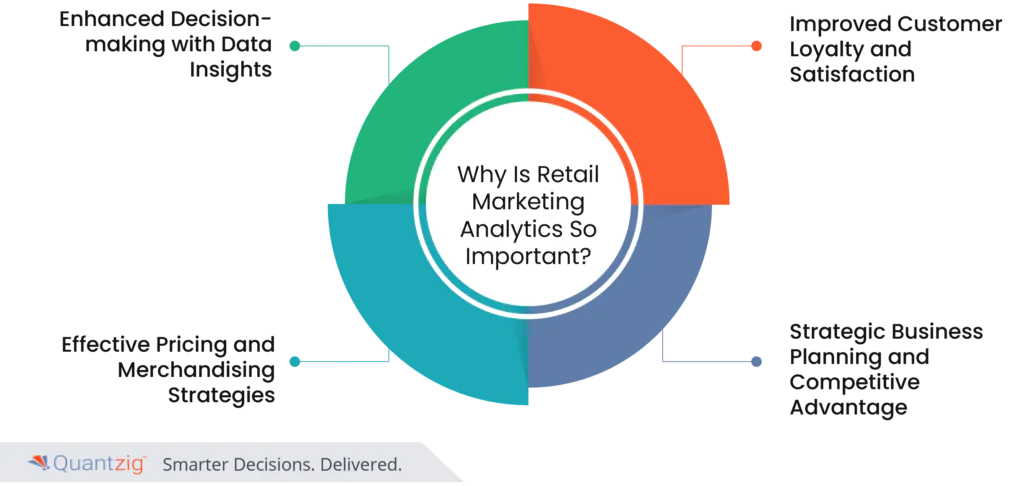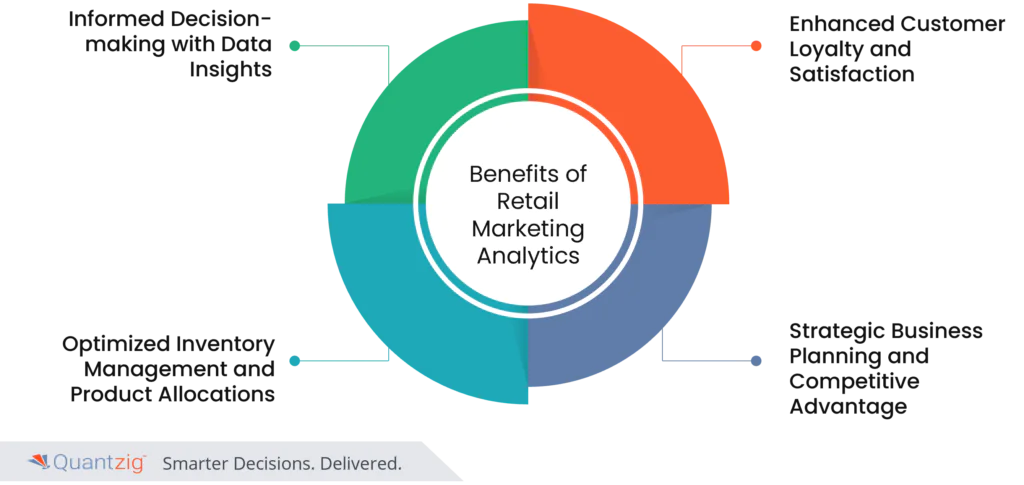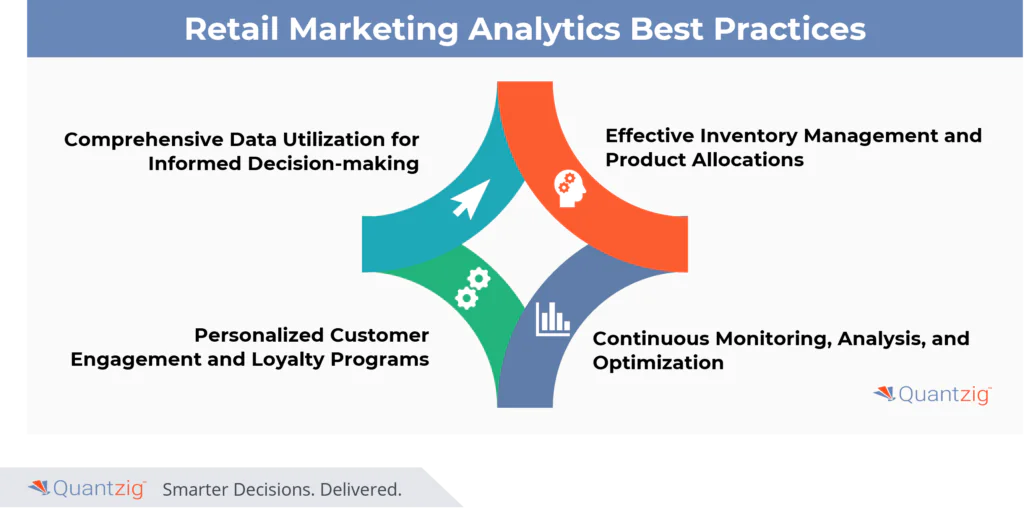Written By: Sudeshna Ghosh
Table of Contents
Key Takeaways of Retail Marketing Analytics
- The analytics-driven approach provides unparalleled visibility into enabling more informed decision-making and continual optimization of marketing strategies for maximum effectiveness.
- Quantzig’s advanced retail analytics revolutionized the retail firm’s strategic marketing and resource allocation, leading to significant cost savings, optimized marketing expenditures, and 10% rise in sales margin.
- The formulation of a comprehensive marketing plan helps with marketing objectives and overarching business strategies, along with higher ROI.
- Implementation of a new multichannel marketing strategy provided invaluable consumer insights into customer behavior and engagement patterns for strategies tailor made to meet evolving consumers’ needs.
Introduction to Retail Marketing Analytics
The retail industry necessitates innovative strategies to drive growth, enhance customer engagement, and optimize profitability. A compelling case study underscores the transformative impact of Retail Marketing Analytics, wherein a retail client witnessed a remarkable 10% rise in sales margin. The deep dive into the success story exemplifies the power of leveraging data-driven insights, advanced analytics tools, and strategic decision-making to unlock untapped potential, streamline operations, and capitalize on market opportunities.
Retail Marketing Analytics, is here for organizations to gain a competitive edge, foster customer loyalty, and achieve sustainable growth in an increasingly dynamic and competitive marketplace.
Book a demo to experience the meaningful insights we derive from data through our analytical tools and platform capabilities. Schedule a demo today!
Request your free Demo nowRetail Analytics for an e-commerce client: A Quantzig success story
| Client Details | A leading e-commerce retailer based on UK renowned for its diverse range of products. |
| Challenges Faced by the Client | The client sought to optimize their marketing strategy by leveraging Quantzig’s solutions to develop a precise marketing plan template aimed at enhancing customer reach, improving profitability, and determining the ideal mix of short-term and long-term marketing activities to achieve sales growth amidst fluctuating market dynamics and short product life cycles. |
| Solutions Offered by Quantzig | Quantzig provided tailored marketing analytics solutions that enabled the client to gain actionable insights into the impact of marketing strategies, optimize marketing spend, enhance ROI through scenario analysis and ROI simulators, and drive strategic decision-making based on quantitative insights, ultimately leading to increased sales, reduced customer acquisition costs, and improved efficiency in multichannel marketing efforts. |
| Impact Delivered | A remarkable 10% rise in sales margin |
Client Details:
Quantzig collaborated with a prominent retail industry leader with a global presence to optimize their marketing strategies and drive sales growth. The client, renowned for its expansive network of retail outlets spanning across geographical locations, sought to enhance its market performance and profitability through data-driven insights and tailored marketing solutions. With a keen focus on leveraging advanced analytics to gain a competitive edge in the highly dynamic retail landscape, the client aspired to maximize the effectiveness of its marketing initiatives and strengthen its position as a leader in the industry.
Challenges Faced by the Client
The client wanted to leverage Quantzig ’s solution to develop a precise marketing plan template. The template was to be used as a roadmap to enhance customer reach and improve the organization’s profits. Additionally, the client wanted to devise the right marketing plan to identify target groups, devise strategies to reach them, and study the future of retail to retain maximum customers.
A leading retail industry player with offices spread across the globe wanted to optimize the mix of short-term and long-term marketing activities to achieve sales growth and increase marketing effectiveness. Additionally, due to the relatively short life cycles for new electronics products, there was a significant dip in their sales. As a result, the retail industry player wanted to determine a proper mix of long-term brand building and short-term marketing activities to increase revenues.
A data-driven, multichannel marketing approach is key to driving sales as a better understanding of customer interactions with your brand empowers you to optimize customer touchpoints and deliver the relevant message, which in turn, ensures the customers engage with your brand while they switch channels. The use of multiple marketing channels also helps you gain a better read on how your campaigns are performing, making sure you spend your marketing dollars efficiently. A multichannel marketing approach is critical to the success of any marketing plan as customers today use several channels to access products and services and often switch channels after a single transaction.
Revolutionary Retail Marketing Analytics Solutions for the Client
With the proper understanding of the problem, this is how Quantzig provided and strategised their soluton.
Client’s Success with Marketing Analytics:
After gaining the desired information about the retail industry, the client was able to assess and identify the impact of marketing on revenue and market shares. The client was also able to increase sales, decrease customer acquisition costs, and further increase the efficiency. Moreover, the client identified the robust marketing campaigns or channels, where the customers interacted before purchasing the products. Robust marketing analytics solution also helped the client identify the average value and quantity of items purchased per transaction to further measure the market performance.
Utilizing Marketing Mix Modeling:
There are many factors that affect sales revenue. A marketing mix strategy helps to examine the major factors which are responsible for explaining the sales variation in a given period by categorizing them into- base factors, macroeconomic factors, and promotions. Constant sales variations due to several such factors prompted a retail industry player to leverage MMM techniques to examine the major factors affecting their sales over of period of time. The client also wanted to use Quantzig’s solutions to measure the impact of their marketing investments on sales and optimize marketing spend.
Tailored Solutions for Specific Requirements:
The requirements of the retail industry client were quite specific, and to meet them our experts collaborated with the client’s team to evaluate the impact of their marketing strategies and develop ROI simulators for scenario analysis and planning. A detailed assessment of the marketing performance of different media platforms offered detailed insights into media contributions and insights. Also, by employing a team of experts with a clear understanding of the client’s industry we offered tailored solutions to help them gain accurate insights into the ROI of their marketing efforts, understand the impact of changing their marketing strategies, and to measure the effectiveness of their overall marketing campaigns.
Insights for Strategic Decision-Making:
Based on their business requirements, the client joined forces with Quantzig’s team to yield a wealth of quantitative insights on the negative impact of competitor sales for products in the same category. The solution helped the client measure the effectiveness of activities by selling seasons. Also, we provided additional insights into how the retailer should reschedule manufacturing activities to support key selling seasons, leading to an increase of 12% in returns.
Multichannel Marketing Solutions:
Quantzig’s marketing analytics experts offered an intelligent, integrated multichannel marketing solution that focused on combining multiple channel data streams to maximize the return on investment from specific customer groups and reduce the rate of cart abandonment. Apart from offering a seamless, consistent experience for their prospects the multichannel marketing strategy enabled the client to improve the customer experience, create targeted messaging, attribute revenue to specific marketing campaigns, and boost the overall MROI. By using a better multichannel marketing strategy the client was able to focus their marketing dollars on specific segments, which in turn, helped them recover nearly 10% of abandoned cart revenue and increase order value from these abandoned carts by over 20%.
Data-Driven Strategic Decisions:
Quantzig’s data-driven marketing strategy helped the client use data to obtain actionable insights and drive strategic decisions. Quantzig’s industry specialists performed a marketing analysis to enhance their business efficiency. Our expertise in analyzing datasets helped this retail grocery chain giant improve the marketing channel’s transparency and enhance accountability and credibility of their marketing strategies.
Retail Marketing Analytics for the E-commerce Industry
In essence, retail analytics eliminates much of the uncertainty in decision-making. While seasoned employees often provide valuable insights, the departure of the baby boomer generation from the workforce means newer employees will have less experience to draw from. Even the most skilled retail executives must navigate numerous internal and external data sources, such as labor strikes, merchandise trends, and weather predictions. Analytics aids retailers in consolidating this data and planning for future events.
Though the sector does not come without challenges of its own. The retailers in the retail space are trying to understand the products and services that are most attractive to the customers. With the altering preferences and shopping trends behaviors of the customers, leading organizations in the retail industry are advocating the need for marketing analytics. This solution helps organizations identify potential customers, devise marketing strategies to attract, retain, and improve the value of the customers, and organize supply chain movement. Also, various retailers are shifting from a product-centric environment to a customer-centric environment to deliver better-targeted messages to specific segments of the retail industry.
Shift to Customer-Centric Approach:
Effectively devising marketing analytics helps retailers identify the customer segments that represent the majority of the sales revenue and margin. To understand the assortments, pricing, service behaviors, and marketing communications, leading businesses are approaching organizations like Quantzig. With years of expertise in offering a plethora of solutions, Quantzig’s solution helps businesses shift toward a more customer-centric business model and determine the most effective marketing campaigns to address the target audience in the retail industry.
Factors Driving Retail Evolution:
The retail industry is a continuously evolving one and the ongoing digitization is driving a new breed of retail that will offer newer experiences to its customers. Disruptions in the form of retail price inflation, customization, and digital disruptions are key factors that define the future of retail. These factors have further leveraged the need to examine the industry from every possible angle and develop a precise marketing plan template that acts as a roadmap to retail success.
Roadblocks in Marketing Success:
A recent survey of several digital advertising decision-makers, including CMOs at some of the largest retailers in the U.S., found that despite the marketing mix being held accountable for growing sales and market share, roadblocks such as increased demands, organizational challenges, and external market forces are impeding success.
Importance of Marketing Mix Modeling:
Marketing mix modeling acts as a decision-making tool that retail industry players can leverage to figure out an optimal spend allocation strategy. It is the process of quantifying the impact of each marketing vehicle in terms of its advertising effectiveness and ROI. Doing so can help create a roadmap for their future strategy by defining how to plan and adjust their marketing budgets, as well as other tasks such as pricing and distribution strategies.
Quantzig’s Solutions in Marketing Mix Optimization:
Quantzig’s solutions assist clients in the retail industry space to increase and maintain market shares based on the optimization of marketing spends. Also, through a robust marketing mix model, businesses can evaluate and improve individual and granular ROIs across channels.
Why Is Retail Marketing Analytics So Important?
Marketing analytics in retail refers to the use of data and statistical methods to analyze marketing efforts and customer behavior in the retail industry. Retailers use various tools and techniques like data mining, demand and supply data analysis, predictive modeling, predictive algorithms, cloud computing, and machine learning to gain insights from vast amounts of customer and sales data. By analyzing customer purchasing patterns, retailers can personalize marketing campaigns, offer tailored promotions, and improve customer engagement. Marketing analytics in retail also enables retailers to evaluate the effectiveness of different marketing channels and allocate resources more efficiently for maximum return on investment.
1. Enhanced Decision-making with Data Insights:
Retail marketing analytics empowers businesses to make informed decisions by leveraging data-driven insights. By analyzing purchasing patterns, demand predictions, and customer behavior through tools such as machine learning and business intelligence software, retailers can tailor their marketing campaigns, pricing strategies, and product allocations to meet the evolving needs and preferences of their target audience. This data-driven approach enables retailers to optimize their inventory management, enhance customer engagement, and improve overall operational efficiency.
2. Improved Customer Loyalty and Satisfaction:
Understanding customer behavior and preferences is essential for fostering long-term relationships and building loyalty. By utilizing retail analytics tools to analyze customer data from various sources such as point-of-sale systems, CRM software, and loyalty programs, retailers can personalize advertising campaigns, offer targeted promotions, and provide exceptional customer service experiences. This personalized approach enhances customer satisfaction, increases brand loyalty, and ultimately drives repeat purchases and higher customer lifetime value.
3. Effective Pricing and Merchandising Strategies:
After analyzing demographic, transactional, and behavioral data, retail marketing analytics enablers can identify pricing trends, determine optimal price points, and adjust pricing strategies in real-time to remain competitive in the market. Additionally, merchandise attribute analytics and inventory planning tools help retailers optimize product assortments, minimize stockouts, and maximize sales opportunities, ultimately leading to improved profitability and revenue growth.
4. Business Planning and Competitive Advantage:
Retail marketing analytics provides retailers with actionable insights derived from internal and external data sources, including market research, psychographic data, and competitor analysis. By leveraging statistical analysis, visualization tools, and recommendation engines, retailers can identify growth opportunities, streamline supply chain movement, and adapt their strategies to changing market dynamics, thereby gaining a competitive advantage and driving sustainable business growth.
Benefits of Retail Marketing Analytics
Businesses rely on comprehensive retail analytics to drive strategic marketing decisions. Utilizing advanced techniques like segmentation and precise metrics, retailers gain deep customer insights and market trends. Through meticulous forecasting, they anticipate shifts in demand and adjust pricing strategies accordingly. Leveraging data from social platforms and rigorous market research, retailers optimize promotion strategies for maximum impact. With a focus on performance across diverse products, businesses identify growth opportunities, ensuring sustainable success amidst evolving consumer demands.
1. Informed Decision-making with Data Insights:
This technique empowers businesses to make strategic marketing decisions based on comprehensive data analysis. By leveraging data analytics software and business intelligence tools, retailers can gain insights into demand and supply data, customer behavior, purchasing patterns, and consumer demand predictions. This allows them to optimize inventory management, organize supply chain movement, allocate products effectively, and adjust pricing and procurement decisions in real-time to meet consumer demands and maximize profitability. Additionally, machine learning algorithms enable retailers to identify trends and patterns in data, facilitating more accurate forecasting and decision-making across various aspects of the retail operations.
2. Enhanced Customer Loyalty and Satisfaction:
Utilizing this tool enables retailers to better understand their customers and tailor marketing campaigns and loyalty programs to meet their needs. By analyzing customer data from POS systems, CRM software, and loyalty programs, retailers can personalize marketing messages, offer targeted promotions, and deliver exceptional customer service experiences. This personalized approach fosters stronger customer relationships, increases customer loyalty, and ultimately drives repeat purchases and higher customer lifetime value, contributing to long-term business success.
3. Optimized Inventory Management and Product Allocations:
These tools provide valuable insights into inventory analytics and merchandise attributes, enabling retailers to optimize inventory planning and management processes. By analyzing transactional data and merchandise attributes, retailers can identify fast-moving products, slow-moving items, and trends in consumer preferences. This allows them to make informed procurement decisions regarding product allocations, inventory replenishment, and assortment planning, minimizing stockouts, reducing excess inventory costs, and improving overall operational efficiency.
4. Strategic Business Planning and Competitive Advantage:
This tool enables retailers to gain a competitive edge by leveraging data from internal and external sources to inform strategic business procurement decisions. By conducting statistical analysis, market research, and consumer behavior studies, retailers can identify market trends, assess competitive threats, and capitalize on emerging opportunities. Additionally, retail analytics facilitates pricing optimization, staffing decisions, and customer engagement strategies, allowing retailers to differentiate themselves in the market and stay ahead of the competition. Ultimately, leveraging retail analytics provides retailers with the insights they need to drive business growth, enhance operational efficiency, and deliver superior customer experiences.
Advanced AI technologies facilitate impactful visualizations, AI and machine learning features, and AI-based data analyses, enhancing ecommerce-site navigation and driving success for fashion retailers. Moreover, prioritizing security practices and leveraging insights from analyst reports and cloud economics fosters corporate responsibility and diversity and inclusion initiatives. Through continuous analysis, retailers uncover business processes and improvement opportunities, ensuring sustainable growth and competitiveness in the ever-evolving retail landscape.
Key Metrics and Key Performance Indicators (KPIs) for Retail Marketing Analytics
In the retail industry, leveraging data analytics is paramount for achieving sustained success. By scrutinizing various metrics and Key Performance Indicators (KPIs), retailers can unearth invaluable customer insights, market trends, demand and supply data analysis, and competitor strategies. This article delves into three critical metrics and KPIs that wield significant influence over profits, pricing strategies, and overall business outcomes, shedding light on their importance in optimizing retail operations.
1. Conversion Rate:
Conversion rate measures the percentage of website visitors or store visitors who complete a desired action, such as making a purchase. This metric directly reflects the effectiveness of retail strategies and the overall customer experience. It provides insights into consumer needs and purchasing patterns, guiding retailers in refining their offerings and optimizing store layouts.
By understanding conversion rates, retailers can tailor their content and promotions to better resonate with their target audience. Moreover, it aids in identifying potential bottlenecks in the purchasing process, facilitating smoother transactions and enhancing customer loyalty.
2. Basket Size:
Basket size, also known as average order value, quantifies the average monetary value of transactions within a given period. Understanding basket size offers retailers a glimpse into consumer spending habits, preferences, and purchasing patterns. It helps in devising effective pricing strategies, bundling discounts, and optimizing product assortments to maximize profits.
By analyzing basket size, retailers can identify opportunities to upsell or cross-sell products, thereby increasing the overall transaction value. Additionally, it aids in tailoring promotional offers and incentives to incentivize larger purchases, ultimately driving revenue growth.
3. Customer Lifetime Value (CLV):
Customer lifetime value represents the total revenue a retailer can expect from a single customer over their entire relationship. CLV is instrumental in gauging the long-term impact of customer interactions and loyalty initiatives. It helps retailers prioritize customer acquisition and retention strategies, allocate resources effectively, and optimize channel investments.
By focusing on enhancing CLV, retailers can foster enduring relationships with customers, leading to repeat purchases, increased brand loyalty, and positive word-of-mouth. Moreover, it enables retailers to differentiate themselves from competitors and sustain profitability in a competitive retail landscape.
Retail Marketing Analytics Best Practices
1. Comprehensive Data Utilization for Informed Decision-making:
Successful implementation of this tool starts with leveraging a wide range of data sources, including customer data, transactional data, and demographic information, to gain deep insights into purchasing patterns, customer behavior, and market trends. Machine learning algorithms facilitate the identification of patterns and correlations within the data, enabling retailers to make data-driven decisions that drive business growth and enhance competitive advantage.
2. Effective Inventory Management and Product Allocations:
A critical aspect of best practices involves optimizing inventory management systems and product allocations to meet customer demand and minimize costs. By analyzing inventory analytics, retailers can identify fast-moving products, anticipate demand fluctuations, and adjust inventory levels accordingly. This ensures optimal product availability, reduces stockouts, and improves overall operational efficiency.
3. Personalized Customer Engagement and Loyalty Programs:
This technique enables retailers to enhance customer loyalty and satisfaction by personalizing marketing campaigns and loyalty programs based on customer preferences and behavior. By leveraging customer data from CRM software and loyalty programs, retailers can segment their customer base, target specific demographics, and tailor promotional offers to individual preferences. Additionally, in-store analytics and customer engagement tools enable retailers to deliver personalized shopping experiences, analyze shopping trends, provide exceptional customer service, and build stronger relationships with customers.
4. Continuous Monitoring, Analysis, and Optimization:
By regularly reviewing key performance indicators, conducting market research, and analyzing consumer behavior, retailers can identify areas for improvement and implement data-driven strategies to drive business growth. Recommendations generated through business intelligence tools and machine learning algorithms provide valuable insights for refining pricing strategies, staffing decisions, and merchandise assortments. By embracing a culture of data-driven decision-making and continuous improvement, retailers can stay agile, responsive, and competitive in the dynamic retail landscape.
Get started with your complimentary trial today and delve into our platform without any obligations. Explore our wide range of customized, consumption driven analytical solutions services built across the analytical maturity levels.
Start your free Trial nowConclusion
In conclusion, the case study highlighting a 10% rise in sales margin through Retail Marketing Analytics underscores the pivotal role of data-driven strategies in reshaping the retail landscape. By embracing advanced analytics, organizations can uncover actionable insights, optimize marketing initiatives, enhance customer experiences, and drive profitability. As the retail industry continues to evolve, leveraging analytics-driven approaches will be instrumental in navigating challenges, capitalizing on opportunities, and achieving sustainable success in today’s competitive marketplace.







